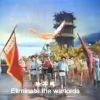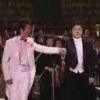Chapter 1: Musical Revolutions in China
The model works are a reminder of this very hard and very bitter time. We heard them from where we were locked up in those “cowsheds” [牛棚], and we found this extremely difficult to bear [难受]. Zhu Jian’er’s First Symphony [1977–86] is criticizing precisely this: the model works are a symbol for how society has been destroyed at that time. (Musician, 1930s–)
I thought I had forgotten about the model works. But then, accidentally during the Spring Festival, I heard someone singing tunes from one of them. They gave me such a creepy feeling that I began having nightmares.... the model works had been forged indelibly on my heart. (Ba Jin, Writer, 1904–2005)
When did China’s Cultural Revolution begin? From the point of view of cultural production, China’s Cultural Revolution did not last just the ten years (1966–76) assigned to it by political fiat since the Party Resolution in 1981. On the contrary, seen from the perspective of cultural production, the Cultural Revolution originated some time in the late nineteenth century and lasts long into the 21st century. In showing the indebtedness of the infamous Cultural Revolution model works to the form and rhetoric of foreign musical style and composition introduced to China since that time, this chapter argues that foreign music was in fact heard and played all throughout the Cultural Revolution. Second, the indebtedness of the model works to the form and rhetoric of traditional musical genres such as Beijing Opera shows that some traditional music was, in fact, redeveloped rather than destroyed during the Cultural Revolution.
In describing the nature of the synthesis between foreign and Chinese musical heritage as found in the model works, this chapter will suggest that they are, yet again, manifestations of the attempt to create a New Chinese Music, a music with national style (民族性 minzuxing or 民族风格 minzu fengge). A short history of opera reform throughout the twentieth century will show that the politicized nature of the model works was also not an affair of the Cultural Revolution alone. Politics and the dictum to “Serve the People” (为人民服务 wei renmin fuwu), musically as well as in everything else, has played a role in the production of Chinese art and culture throughout the twentieth century.
Finally, I will argue that composers who emerged out of the Cultural Revolution—those urbanites who may have suffered greatly from having been sent to the countryside during this time or who had become members of the numerous music ensembles and propaganda troupes traveling around the country—were confronted in a much more intimate manner with the rich traditions of Chinese folk music than many a generation of Chinese composers before and after. Their particular understanding and reinterpretation of traditional and folk music became a crucial element in the new types of synthesis with the forms and styles of contemporary music, or “New Music,” proffered since the mid-1980s.
While their “Chinese New Music,” yet again, shows new variations of music in the so-called “national style” (民族风格 minzu fengge) and thus offers the possibility of reviving rather than destroying the traditional music of China, it is a practice they had learned to appreciate during the Cultural Revolution (Kouwenhoven 1990–92; Mittler 1997; Tuohy 2001a; Yu 2004). To talk about Cultural Revolution music, then, is not to talk about the music of a single decade, but to deal with a continuous revolution of particular musical trends dominant throughout the twentieth century and into the twenty-first. As one artist put it, “Behind all the theater a greater reality is hidden” (Xu Yihui 徐一晖, Artist, 1964–, in Yang Ban Xi 2005).





















